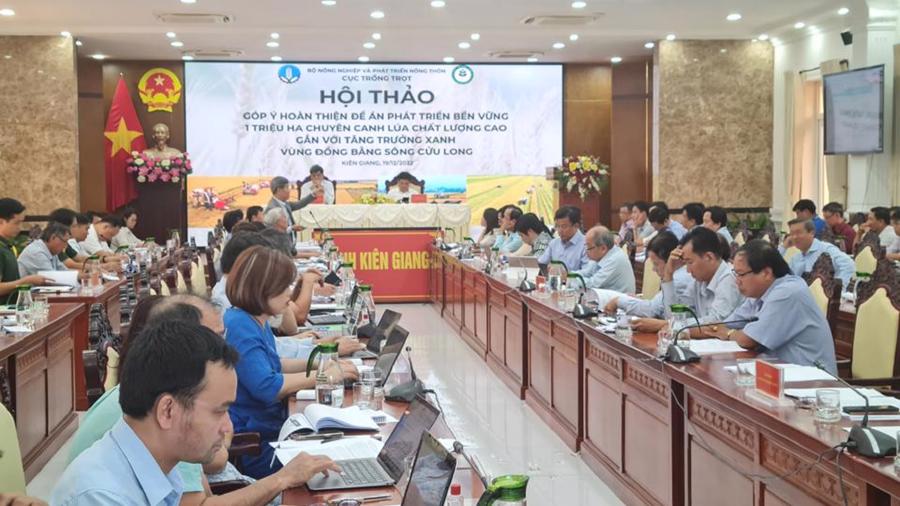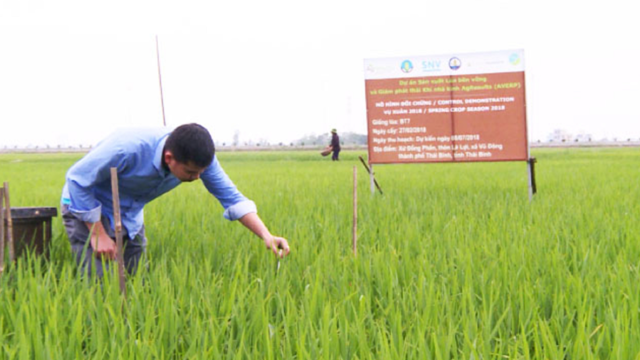[ad_1]
On the afternoon of December 19, the Ministry of Agriculture and Rural Development in the People’s Committee of Kien Giang Province held a workshop to make proposals to complete the one million hectare sustainable development project, which specializes in high-quality rice cultivation combined with green growth in the river delta kowloon
ESTABLISHING “GREEN” STANDARDS FOR HIGH QUALITY RICE
Mr. Tran Thanh Nam, Deputy Minister of Agriculture and Rural Development, said that the Prime Minister has directed the Ministry of Agriculture and Rural Development to develop a program for the sustainable production of 1 million hectares of high-quality specialty rice to reduce greenhouse gas-emissions in the Mekong Delta.
The development of this project is also part of the Sustainable Agriculture and Rural Development Strategy 2021-2030 with a vision up to 2050. In order to complete the project, for the second time the Ministry is organizing a workshop to hear opinions from scientists, experts, leaders of the Mekong Delta Provinces and Corporations.

According to Vice Minister Nam, the Mekong Delta is the rice bowl of the whole country, in recent years the region’s rice production has reached about 24-25 million tons/year. In the period from 2010 to 2022, the area under rice fell, but production did not decrease and increased significantly.
Mr. Tran Thanh Nam clarified the project’s point of view: Building a material area of 1 million hectares of high-quality specialty rice does not mean that there is a fixed plan in terms of the location of the specific rice area assigned to each province.
The Department of Agriculture and Rural Development is developing basic criteria for high-quality 1 million hectares of specialized rice paddy land to reduce greenhouse gas emissions.
“The winter-spring harvest in the Mekong Delta has a rice yield of more than 7 tons/ha, the highest in the ASEAN region and at the top of the world. Strongly shift rice production towards sustainability and green growth”.
Mr. Tran Thanh Nam, Deputy Minister of Agriculture and Rural Development.
Based on these standards, Mekong Delta communities, industry associations, rice production and trading companies, cooperatives and farms will voluntarily designate and register the development area. The Ministry of Agriculture and Rural Development will take supporting measures to encourage companies, cooperatives and farmers to implement.
According to the Ministry of Agriculture and Rural Development, standards for quality rice production coupled with green growth focus on many factors.
Firstthe use of certified high quality rice varieties, which can meet the increasing demands of domestic and international consumers, can aim to use rice varieties that meet consumer nutritional needs and the demand for deep processing, and create value-added rice grain products.
second, apply sustainable cultivation methods, reduce greenhouse gas emissions. High-quality rice areas need to adopt more sustainable farming practices and use input materials towards reducing chemical fertilizers, pesticides, seeds, etc. With this cultivation system, rice production will conserve resources, have less impact on the environment and reduce emissions.
Tuesday, high-value rice areas, production will be restructured in the direction of promoting cooperation and unification to reduce production costs and increase the value of production, processing and consumption links. Farm households will be reorganized into cooperative groups and cooperatives, and more closely linked to business enterprises that provide input materials and enterprises that consume outputs, in the direction that farmers are entitled to inputs, provide high-quality inputs at a lower price, and sell rice at one stable, higher price.
WednesdayLarge, high-quality rice fields are mechanized, investing in a more synchronous infrastructure system, growing areas digitized, traceable and integrated with intelligent technologies, disease control, automatic irrigation …
ThursdayHigh-quality specialized rice growing areas must be invested in sustainable development to provide confidence and higher incomes for rice farmers and help farmers feel safe to invest in rice production, while adding value to specialized areas by helping reduce greenhouse gas emissions to reduce, save resources, reuse rice by-products under the circular economy model and build rice brands. .
DON’T JUST GROW RICE FOR RICE BUT SELL CARBON CREDIT
Mr. Le Quoc Anh, vice chairman of the People’s Committee of Kien Giang Province, said the province’s rice output will reach 4.4 million tons in 2022, of which 97.32% will be high-grade rice and specialty rice. Also, there are 109,000 hectares of related consumption, all of which meet Global Gap standards and organic rice. Kiem Giang Province has boldly signed up to produce 200,000 hectares specializing in high-quality rice cultivation combined with green growth.
“The main thing of the project is the issue of organization of production related to reduction of greenhouse gas emissions. The most difficult part of the reorganization of production is the signing with companies and cooperatives. It is necessary to organize good networking. and requires a government commitment and separate policy for this project”.
associate dr Bui Ba Bong, senior agricultural expert, former Deputy Minister of Agriculture and Rural Development.
According to experts at the conference, rice farmers in the Mekong Delta are now breaking even or making very little profits. Therefore, in the development of the project, emphasis must be placed on increasing the income of rice farmers. At present, only about 10% of the country’s rice area is linked between farmers and companies, in order to effect 1 million hectares of high-quality rice, this figure must be increased to 100%.
Ms. Le Hoang Dai Trang, CEO of Gavi Joint Stock Company, said that if 160 million tons of agricultural by-products were well exploited annually, there would be 40 million tons of organic fertilizer. This helps to significantly reduce greenhouse gas emissions compared to chemical fertilizers, loosens the soil and minimizes the impact on farmers’ health.
Cao Thang Binh, a World Bank expert, said that rice cultivation is the largest source of greenhouse gas emissions in the agricultural sector, emitting about 49.6 million tons of CO2 per year. Lessons learned from the VnSAT project show that applying “1 must 5 reduction” in rice cultivation can increase yield by 5%, increase net profit by 28.6% and reduce CO2e by approximately 8 tCO2/ha/5.
“We need to produce high-quality rice, we need to save money…but we need to focus on carbon trading in addition to rice trade in the next five years, which is also a joint contribution to the government,” said Mr. Cao Thanh, stressed Binh.
[ad_2]
Source link

